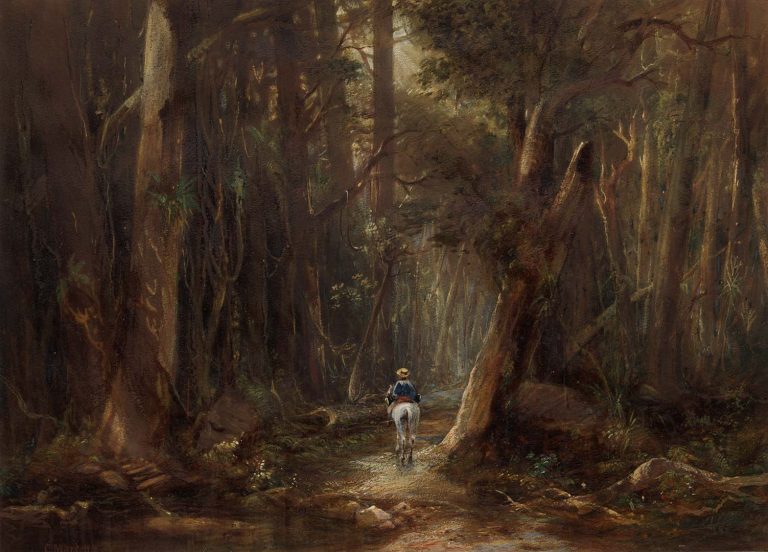We acknowledge the Traditional Owners of the land on which the Queensland Art Gallery | Gallery of Modern Art stands and recognise the creative contribution First Australians make to the art and culture of this country.

Conrad Martens / England/Australia 1801–78 / Forest, Cunningham’s Gap 1856 / Watercolour on paper / 30.5 x 42cm / Purchased 1998 with funds raised through The Conrad Martens Queensland Art Gallery Foundation Appeal and with the assistance of the Queensland Government’s special Centenary Fund / Collection: Queensland Art Gallery | Gallery of Modern Art
Conrad MartensForest, Cunningham’s Gap 1856
Not Currently on Display
Conrad Martens’s Forest, Cunningham’s Gap 1856 is an excellent adaptation of the Romantic sublime — the influential eighteenth-century artistic mode that ‘connected the sublime with experiences of awe, terror and danger’1 — to the pioneering spirit of nineteenth-century Australia.
Cunningham’s Gap is the famous route over the Great Dividing Range between Moreton Bay and the Darling Downs. It is named for botanist Allan Cunningham, who traversed it in 1828. The Gap and its surrounds, including the lush rainforest of the Great Dividing Range, is a site of cultural significance to Indigenous Australians, and includes the World Heritage-listed Main Range National Park west of Beaudesert, Queensland.
The painting accounts for the terrors of exploring an unknown land and the relative insignificance of the individual, dwarfed here by the natural world. The image of this solitary horseman facing a mighty forest could be read as symbolic of youthful hope, courage and hardiness, and the beginning of a new life in what would soon become Queensland.
Endnotes:
1 Drawn from ‘The Romantic sublime’, in Nigel Llewellyn and Christine Riding (eds), The Art of the Sublime, Tate Research Publication, January 2013, https://www
Conrad Martens was born at Crutched Friars, near the Tower of London, in 1801, to a German father and English mother. At the age of 16, he became a pupil of English landscape painter Anthony Vandyke Copley Fielding.
After working as a topographical artist on the Hyacinth, in 1833 Martens met Robert FitzRoy, captain of the British vessel HMS Beagle, and FitzRoy engaged him as the ship’s artist. During the voyage, Martens established an enduring friendship with famous naturalist Charles Darwin. The artist later disembarked in Chile and made his own way to Australia via Tahiti.
Settling in New South Wales in 1835, Martens achieved immediate and enduring recognition as the most proficient and prolific landscape artist in the Australian colonies. He sailed north to Brisbane in late 1851, where he received many commissions, travelling through the Darling Downs at a time of early European settlement in the region.
In the early 1860s, Conrad Martens took a position at the Parliamentary Library to make ends meet, and while this curtailed the time he could spend on his art, he was commissioned for two major public works and also entered the Paris International Exhibition in 1867. He continued to paint until a few days before his death in 1878.
Endnotes:
See Elizabeth Ellis, ‘The life of Conrad Martens’, Queensland Visual Arts Online, Queensland Art Gallery, Brisbane, accessed online 27 April 2017.
Discussion Questions
1. Explore the ‘Northern Journey’ QAGOMA interactive from 2001 to learn about the sketching journey that Conrad Martens embarked upon in 1851. (Note: you can access the interactive without Adobe Flash, but if prompted you may choose to download the software for optimal use of the interactive).
2. ‘The first Europeans to settle the Darling Downs arrived in the early 1840s. By 1851, when Conrad Martens crossed Cunningham’s Gap, nearly all the land had been taken up by a small, close-knit group of young men, the squatters of the Darling Downs.’ On what grounds would have the squatters claimed ownership of the land?
Activities
Use the information on the Department of Environment and Science website for the Main Range National Park, to list a timeline of major events that occurred between 1828 and 1856 (the year that Martens executed this painting). Map your timeline by using the links to guides on the National Park website. Refer to Noel McKenna’s Queenslander 2004 for inspiration.